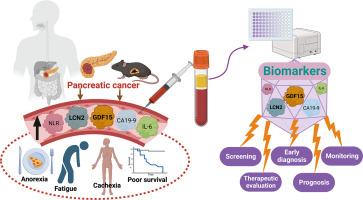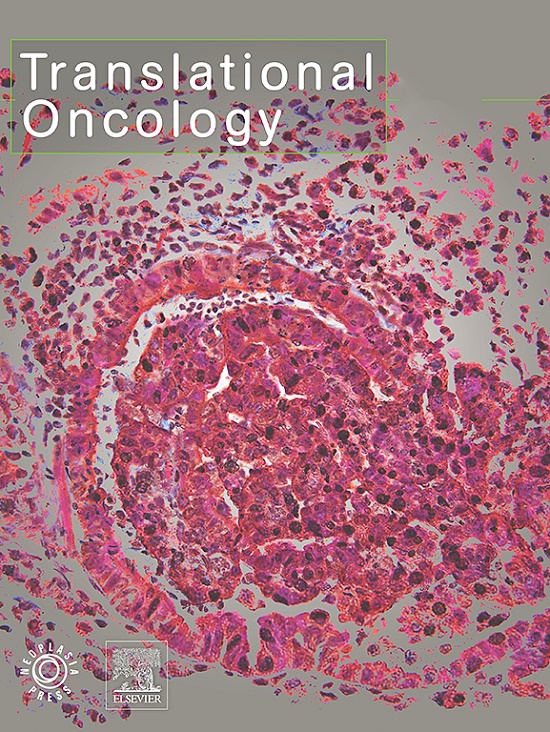用于胰腺癌早期检测和预后判断的 GDF15 和 LCN2
IF 5
2区 医学
Q2 Medicine
引用次数: 0
摘要
背景胰腺导管腺癌(PDAC)的预后仍然很差,强调了早期检测的重要性,而生物标记物在这方面具有独特的潜力。尽管生长分化因子 15 (GDF15) 和脂联素 2 (LCN2) 与 PDAC 有关,但它们作为生物标志物的确切作用尚不确定。为了进行比较,还测量了IL-6、CA19-9和中性粒细胞与淋巴细胞比值(NLR)的循环水平。评估了 PDAC 进展与总生存期之间的相关性。小鼠 PDAC 模型被用来进行综合分析,通过探索与各种代谢和炎症参数的关联来补充人体研究。我们的研究结果表明,与健康对照组和良性胰腺疾病患者相比,PDAC 患者的循环 GDF15 和 LCN2 水平升高,GDF15 水平升高与疾病进展和死亡率增加有关。在 PDAC 小鼠中,循环 GDF15 和 LCN2 逐渐升高,与肿瘤生长、行为表现、组织和分子病理学以及恶病质发展相关。与 CA19-9、IL-6 或 NLR 相比,GDF15 对 PDAC 患者具有高度敏感性和特异性,而 LCN2 在 PDAC 小鼠中显示出更高的敏感性和特异性。我们的研究结果表明,GDF15有望成为PDAC早期检测和预后的生物标记物,而LCN2则可以加强诊断面板。本文章由计算机程序翻译,如有差异,请以英文原文为准。

GDF15 and LCN2 for early detection and prognosis of pancreatic cancer
Background
The prognosis of pancreatic ductal adenocarcinomas (PDAC) remains very poor, emphasizing the critical importance of early detection, where biomarkers offer unique potential. Although growth differentiation factor 15 (GDF15) and Lipocalin 2 (LCN2) have been linked to PDAC, their precise roles as biomarkers are uncertain.
Methods
Circulating levels of GDF15 and LCN2 were examined in human PDAC patients, heathy controls, and individuals with benign pancreatic diseases. Circulating levels of IL-6, CA19-9, and neutrophil-to-lymphocyte ratio (NLR) were measured for comparisons. Correlations between PDAC progression and overall survival were assessed. A mouse PDAC model was employed for comprehensive analyses, complementing the human studies by exploring associations with various metabolic and inflammatory parameters. Sensitivity and specificity of the biomarkers were evaluated.
Findings
Our results demonstrated elevated levels of circulating GDF15 and LCN2 in PDAC patients compared to both healthy controls and individuals with benign pancreatic diseases, with higher GDF15 levels associated with disease progression and increased mortality. In PDAC mice, circulating GDF15 and LCN2 progressively increased, correlating with tumor growth, behavioral manifestations, tissue and molecular pathology, and cachexia development. GDF15 exhibited highly sensitive and specific for PDAC patients compared to CA19-9, IL-6, or NLR, while LCN2 showed even greater sensitivity and specificity in PDAC mice. Combining GDF15 and LCN2, or GDF15 and CA19-9, enhanced sensitivity and specificity.
Interpretation
Our findings indicate that GDF15 holds promise as a biomarker for early detection and prognosis of PDAC, while LCN2 could strengthen diagnostic panels.
求助全文
通过发布文献求助,成功后即可免费获取论文全文。
去求助
来源期刊

Translational Oncology
ONCOLOGY-
CiteScore
8.40
自引率
2.00%
发文量
314
审稿时长
54 days
期刊介绍:
Translational Oncology publishes the results of novel research investigations which bridge the laboratory and clinical settings including risk assessment, cellular and molecular characterization, prevention, detection, diagnosis and treatment of human cancers with the overall goal of improving the clinical care of oncology patients. Translational Oncology will publish laboratory studies of novel therapeutic interventions as well as clinical trials which evaluate new treatment paradigms for cancer. Peer reviewed manuscript types include Original Reports, Reviews and Editorials.
 求助内容:
求助内容: 应助结果提醒方式:
应助结果提醒方式:


